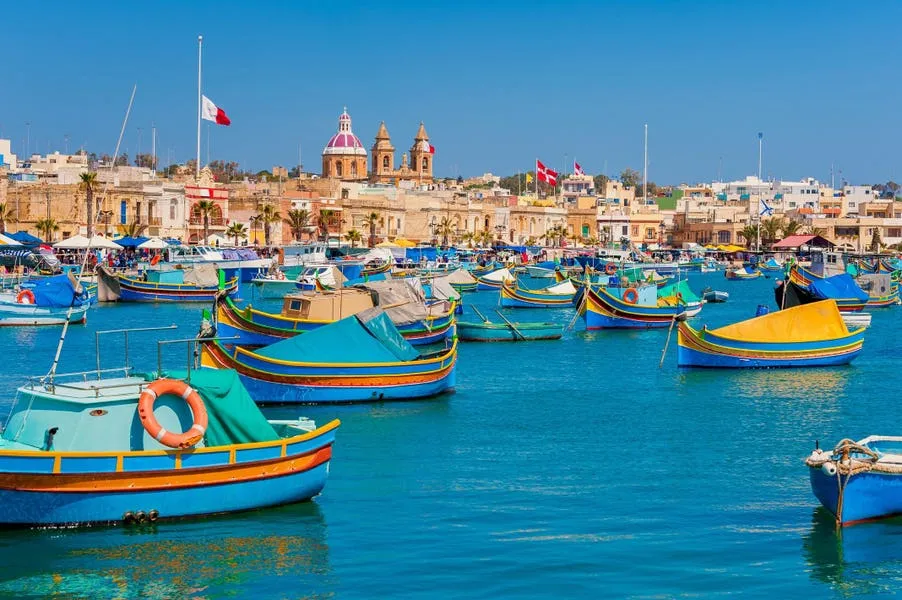This small island in the Mediterranean is one of the closest to North Africa and has been a hotbed of conflict, colonization and military maneuvers during the war. The Maltese national language is closer to Arabic than any other language. Residents say that the language of Malta is completely copacetic with Lebanese Arabic and is it said the pronunciation of basic numbers is exactly the same as Arabic.
This island is a UNESCO heritage site and Gladiator II was reportedly filmed in Valletta, given its resemblance to ancient Rome. While the island is full of great food offerings, it is a bit disappointing that many of the shops and bigger restaurants have moved out of the historic center, as more modern areas such as Sliema have become a bigger draw.
Malta has been producing wines for centuries. The winemakers use a number of international varietals but also have their own indigenous grapes -- such as Girgentina and Ġellewża -- which are challenging to pronounce.
The heat of the island works against local wine producers, as well as the fact that Maltese -- like the Swiss and Austrians -- also enjoy their own wines so much few of them make it out of the country. The bottom line is that unfortunately not much Maltese wine is available in the States.
I had a chance to visit a few great wineries. One was Markus Divinus, whose owner is making completely unique wines with a mix of local and international varietals. I particularly liked the white Zafrana, which is primarily based on the the indigenous Girgentina grape with international varieties, on the nose it has stone fruit and mineral notes. Only 1,434 bottles were made of the 2023 vintage, which clearly demonstrates why these wines are hard to find outside the country. The winery's tasting room is darling with lights hung outside and black and white pictures of owner Mark Borg's family producing wine.
Unfortunately, the bulk of these wines, when sold directly, from the winery are coming in at more than $50 a bottle retail which is a price point that few Americans would be willing to experiment with an unknown wine. It's the same issue that Georgian, Armenian and Serbian wines are facing. Only a small set of locals can afford to buy the wines and the math doesn't work on exporting them profitably.
However, I totally enjoyed tasting the local wines and seeing them paired on menus. Another winery I enjoyed visiting was Meridiana, which is owned by noted Italian winemaker Piero Antinori, who has been an aggressive player in the international wine industry. He also owns a winery called Metaforsis, that I have visited in the Dealu Mare region of Romania, and he instinctively seems to quietly understand how to expand his empire. At Meridiana the Nexxus Merlot was good with intense cherry and berry flavors.
Malta is home to a pretty impressive number of Michelin-starred restaurants. So, the destination is playing in the big leagues for a 122 square-mile island. I had the privilege of going to two of them. Ion Harbour, a two-star Michelin, is run by British chef Simon Rogan.
Its location on the harbor is peerless: you can stare at endless ocean for hours. While its food merits the two stars, the restaurant could probably use a little support in managing reservations and guest arrival, which were bumpy.
Highlights from the meal included a rosemary-infused pumpkin from Hokkaido Japan with sticky yolk and cheese sauce. I also loved the playful beef fat and koji waffle made with with sheep's yogurt and orange jam.
Another great Michelin dining experience was had at LeGV. It is in the trendy heart of Malta's Sliema district, so the views aren't classic but the food is great. The space sits atop a modern building with stunning views of the surrounding area. The staff is flawless and local wines, like Marcus Divinus' are offered in abundance. Quail, white asparagus and veal: sign me up. I just wish the portions had been smaller and I had had space for cheese (and that I didn't need to wake up at 2am to catch my flight).
Valletta is a charming preserved city much like Ortiga in Siracusa. It's beautiful and historic but is somewhat limited in terms of its food and shopping options.
Leglegin, nestled on a back street, was one of the best meals I had in the area. It is run by an enthusiastic, second generation restaurateur. Check: great local wines, small bite and an amazing typical rabbit dish. A great new fact that I learned was that Maltese rabbits are plumper than American ones, as they are farm raised.
If there is one hotel that says it all about history, and war, in Malta it is the endlessly gracious The Phoenicia. It sits within the City's ancient fortifications, just outside Valletta proper, and even has an infinity pool that juts out over the City.
It was once, of course, where Queen Elisabetta once stayed. She and Prince Philip even lived in Malta for a few years as a newly married couple. The Phoenicia's gardens are divine and the restaurant has a gracious perch. Specialties include a lobster salad and crispy corn on the cobb. It features a number of local wines on the list, such as sparkling Marsovin wines.
